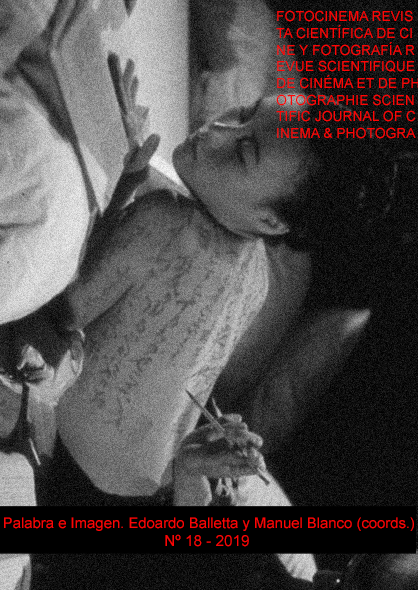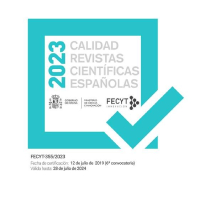Title sequences as film heritage. From informative documents to artwork
DOI:
https://doi.org/10.24310/Fotocinema.2019.v0i18.5512Keywords:
Title Sequences, Opening Credits, Graphic Signs, Film Archeology, Ramón de Baños, Manuel Hernández SanjuánAbstract
During the first decades of Cinema History, before the electronic character generators were invented, title sequences were drawn in paper, filmed and manually edited in the movies. One of the many anonymous members of the technical team, usually skilled in the craft of design, was put in charge of drawing the signs, the textual and graphic symbols with whom the film story begun. The vast majority of those papers has been lost, but there are still examples that allow us to study how credit titles were made before the electronic and digital systems irrupted in the cinematographic industry. This article analyzes the physical, functional and symbolic role of these documents based on the study of a collection of signs and credit titles that are preserved in the Spanish Film Library and that have been catalogued by the author of this contribution. These papers include title sequences designed by Ramón de Baños and Manuel Hernández Sanjuán, two important filmmakers in the History of Spanish Cinema.
Downloads
Metrics
References
Allison, D. (2002). Promises in the Dark. Opening Title Sequences in American Feature Films of the Sound Period. Norwich: University of East Anglia, Phd Thesis. http://ethos.bl.uk/OrderDetails.do?uin=uk.bl.ethos.247223
Allison, D. (2006). Novelty Title Sequences and Self-Reflexivity in Classical Hollywood Cinema. Screening the Past, 20. http://tlweb.latrobe.edu.au/humanities/screeningthepast/20/novelty-title-sequences.html
Allison, D. (2015). Film Title Sequences and Widescreen Aesthetics. Film International, 13 (4), 6-19.
Allison, D. (2011). Beyond Saul Bass. A Century of American Film Title Sequences. Film International, January 30th 2011. http://filmint.nu/?p=202
Aran, I.Z. (2011). Investigation of Title Sequences, which is one of the elements that Enhance Film Narrative. En Zhou, Q.Y., 2011 International Conference on Applied Social Science, vol II, 117-121. Changsha, Peoples R. China: Hong Kong University of Science & Technology
Bass, J. & Kirkham, P. (2011). Saul Bass. A Life in Film and Design. London, Laurence King Publishing.
Blancas Álvarez, S. (2002). El diseño gráfico y el cine: secuencias de títulos diseñados por Saul Bass 1954-1995. Granada: Universidad de Granada.
Blancas Álvarez, S. (2016). Animando los títulos cinematográficos: de los pioneros a Saul Bass. Con A de Animación, 6, 118-134. https://doi.org/10.4995/caa.2016.4800
Bordwell, D., Staiger, J. & Thompson, K. (1997). El cine clásico de Hollywood. Barcelona, Paidós.
Braha, Y. y Byrne, B. (2013). A brief history of title sequences. En Creative Motion Graphic Titling for Film, Video and the Web. London: Focal Press.
Cabero, J.A. (1949). Historia de la Cinematografía Española. Once Jornadas: 1896-1948. Madrid, Gráficas Cinema.
Cardona, R. (1999). Instalación y equipamiento de los primeros laboratorios cinematográficos españoles. Archivos de la Filmoteca. Revista de estudios históricos sobre la imagen, 32, 58-65.
Cerdá, M. (2008). Arqueología industrial. Valencia, Universitat de València.
De Lasa, J.F. (1996). Els Germans Baños: aquell primer cinema català. Barcelona, Generalitat de Catalunya – Departament de Cultura.
Gamonal Arroyo, R. (2005). Títulos de crédito. Píldoras creativas del diseño gráfico en el cine. Icono14. Revista científica de comunicación y tecnologías emergentes, 3 (2), 43-67. https://doi.org/10.7195/ri14.v3i2.418
García Maroto, E. (1988). Aventuras y desventuras del cine español. Barcelona, Plaza y Janés.
González-Monaj, R. (2016). Pablo Núñez. Los créditos de la imaginación. Con A de Animación, 6, 30-41. https://doi.org/10.4995/caa.2016.4787
Horak, J.C. (2014). Saul Bass. Anatomy of Film Design. Lexington, University Press of Kentucky.
Klecker, C. (2015). The other kind of film frames: a research report on paratexts in film. World and Image, 31 (4), 402-413. https://doi.org/10.1080/02666286.2015.1053035
Llorens, A. & Uris, P. (2001). Miles de metros: a propósito de Pablo Núñez. Huesca: Festival de Cine de Huesca.
López, J. (1960). Cine documental español. Madrid, Ediciones Rialp.
Noordegraaf, J.; Saba, C.G.; Le Maître, B; Hediger V. (eds). (2013). Preserving and Editing Media Art. Challenges and Perspectives. Amsterdam: Amsterdam University Press.
Parikka, Jussi (2012). What is Media Archaeology. Malden: Polity Press.
Ramírez Barredo, B. (2016). Los títulos de crédito. Marca de las películas. Madrid: UCM. https://eprints.ucm.es/41930/1/T38581.pdf
Rey, E. (2013). Los títulos de crédito como marco. Un análisis dentro del llamado cine histórico. III Congreso Internacional de Historia y Cine: modelos de interpretación para el cine histórico. Santiago de Compostela: Universidad de Santiago de Compostela.
Rey, E. (2016). Los títulos de crédito como marco de la obra fílmica. 1958-1969. Tesis Doctoral. Barcelona: Universitat Pompeu Fabra. https://www.tdx.cat/handle/10803/350566
Sánchez, M.B. (2017). Ramón de Baños y la versión española de los títulos de crédito de “La corona de hierro” (1941), de Alessandro Blasetti. V Congreso Internacional de Historia y Cine: escenarios del cine histórico. Madrid, Universidad Carlos III. https://e-archivo.uc3m.es/handle/10016/24818
Solana, G. & Boneu, A. (2007). Uncredited. Diseño gráfico y títulos de crédito. Barcelona, Index Books.
Solana, G. & Boneu, A. (2016). Secuencias de títulos de animación en series de ficción. Un paisaje general. Con A de Animación, 6, 96-102. https://doi.org/10.4995/caa.2016.4798
Stanizek, G. (2009). Reading the Title Sequence. Cinema Journal, 48, nº4, pp.44-58. https://muse.jhu.edu/article/317402
Truffaut, F. (2010). El cine según Hitchcock. Madrid, Alianza Editorial.
Tylski, A. (2008). Le générique de cinéma. Histoire et fonctions d’un fragment hybride. Toulouse, Presses Universitaires du Mirail.
Zons, A. (2015) Projecting the Title. World and Image, 31 (4), 442-449. https://doi.org/10.1080/02666286.2015.1053038
Downloads
Published
How to Cite
Issue
Section
License
All contents published in Fotocinema Revista científica de cine y fotografía are protected under the Creative Commons Attribution-NonCommercial-ShareAlike 4.0 International (CC BY-NC-SA 4.0) license. All about this license is available in the following link: <http://creativecommons.org/licenses/by-nc-sa/4.0>
Users can copy, use, redistribute, share and exhibit publicly as long as:
- The original source and authorship of the material are cited (Journal, Publisher and URL of the work).
- It is not used for comercial purposes.
- The existence of the license and its especifications are mentioned.
There are two sets of authors’ rights: moral and property rights. Moral rights are perpetual prerogatives, unrenounceable, not-transferable, unalienable, imprescriptible and inembargable. According to authors’ rights legislation, Fotocinema. Revista científica de cine y fotografía recognizes and respects authors moral rights, as well as the ownership of property rights, which will be transferred to University of Malaga in open access. The property rights are referred to the benefits that are gained by the use or the dissemination of works. Fotocinema. Revista científica de cine y fotografía is published in an open access form and it is exclusively licenced by any means for doing or authorising distribution, dissemination, reproduction, , adaptation, translation or arrangement of works.
Authors are responsable for obtaining the necessary permission to use copyrighted images.













13.png)



